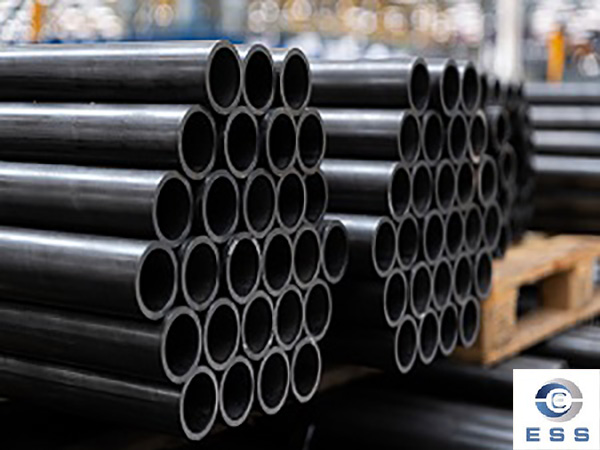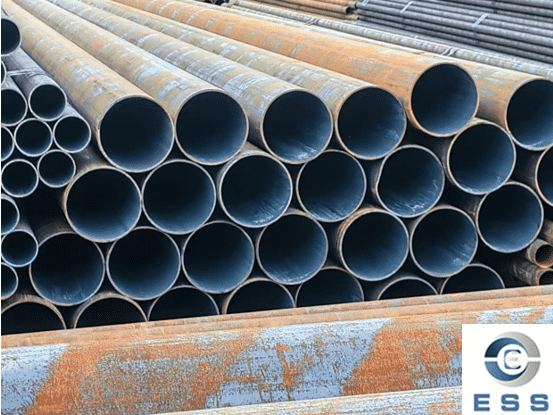Steel pipes are an indispensable basic
material in engineering projects such as construction, machinery manufacturing,
and oil pipelines. However, faced with the wide variety of steel pipe products
on the market, many buyers and engineers are often confused: what exactly is
the difference between mild
steel pipe and carbon
steel pipe? Mild steel pipes and carbon steel pipes differ
significantly in several dimensions, including chemical composition,
properties, applications, cost, weldability, and corrosion resistance.
Mild Steel Pipe Meaning
Mild steel pipes ( MS pipe full form) ,
also known as carbon steel pipes, have a lower carbon content, typically
between 0.05% and 0.25%. Compared to high-carbon steel, mild steel pipes have
better ductility and are easier to process. Due to their excellent weldability,
machinability, and economy, mild steel pipes are widely used in structural and
industrial fields.
Mild steel pipes properties:
Low carbon content (0.05%–0.25%);
High ductility and forgeability;
Excellent weldability;
Medium tensile strength;
Susceptible to corrosion without additional
coating or galvanizing;
Suitable for large-scale applications, high
cost-effectiveness.
Carbon Steel Pipe Meaning
Carbon steel pipes ( CS pipe full form) have
a higher carbon content (0.25% to 2.0%), making them stronger and more durable
than ordinary mild steel pipes. The higher carbon content increases hardness
and wear resistance but reduces ductility. Carbon steel pipes are commonly used
in high-pressure applications, oil and gas pipelines, and heavy industrial
environments.
Carbon steel pipes properties:
Higher carbon content (0.25%–2.0%);
Higher strength and hardness;
Poorer flexibility and weldability compared
to ordinary low-carbon steel;
Higher wear resistance and impact
resistance;
More prone to rust and corrosion without
protective coating;
Suitable for high-pressure and structural
applications.
|
Property
|
Carbon steel
|
Mild steel
|
|
Strength
|
Higher strength
|
Lower strength
|
|
Corrosion resistance
|
Low ( but slightly better than mild
steel)
|
Low ( needs coating )
|
|
Ductility
|
Less ductile
|
Highly ductile
|
|
Weldability
|
Harder to weld
|
Easy to weld
|
|
Machinability
|
Harder to machine
|
Easier to machine
|
|
Price
|
More expensive
|
Less expensive
|

Mild Steel Pipe vs. Carbon Steel Pipe
1. Differences in Chemical Composition
Carbon Content: Low-carbon steel generally
has a carbon content below 0.25%; medium-carbon steel generally has a carbon
content between 0.25% and 0.60%; high-carbon steel generally has a carbon
content above 0.60%.
Besides carbon (C) and certain amounts of
silicon (Si) (generally not exceeding 0.40%) and manganese (Mn) (generally not
exceeding 0.80%, with a maximum of 1.20%) used for deoxidation, steel does not
contain other alloying elements (except for residual elements).
Generally, steel with a carbon content
below 0.02% is called wrought iron, steel with a carbon content between 2.11%
and 4.3% is called pig iron, and steel is defined as steel in between.
Mild steel has the lowest carbon content
among carbon steels, possessing the best machinability and weldability, and is
therefore widely used in construction and piping systems.
2. Application Differences
Main uses of mild steel pipes:
Building structures (angle steel, channel
steel, rectangular tubes, round tubes)
Water, gas, and low-pressure oil
transportation pipelines
Fire protection pipelines, HVAC pipelines
Automotive manufacturing (body panels,
stamped parts)
Machinery and appliance housings
Parts that can be carburized (e.g.,
sprockets, bushings, shafts)
Main uses of medium-carbon/high-carbon
steel pipes:
Suitable for applications requiring high
load-bearing capacity and wear resistance:
Railway tracks
Prestressed steel
Wire ropes
Knives, saw blades
Gears, chains
High-pressure, high-temperature pipelines
(e.g., ASTM A106)
3. Cost Differences
Carbon steel contains approximately 0.05%–1.70% carbon (by weight). Increasing the carbon content in steel can
enhance its strength and is considered the most economical way to improve steel
strength. However, increasing the carbon content also leads to increased
brittleness and decreased ductility.
Therefore, the carbon content must be
balanced to obtain the desired additional properties of the steel. High-carbon
steel has a carbon content between 0.3% and 1.70%, while low-carbon steel has a
carbon content between 0.05% and 0.15%.
Mild steel pipes are among the lowest-cost
and most in-demand steels, making them widely used in the construction
industry, fire protection systems, and general transportation applications.
4. Differences in Strength and Durability
Carbon steel pipes, due to their higher
carbon content, have higher strength and hardness, making them ideal for heavy
industrial applications.
Mild steel pipes, on the other hand, have
better flexibility and ductility, making them easier to process and install.
5. Differences in Corrosion Resistance
Neither low-carbon nor carbon steel pipes
are corrosion-resistant and must be protected with coatings or galvanizing.
Common corrosion-resistant methods include:
Black varnish
Hot-dip galvanizing (HDG)
Cold galvanizing (GI)
Epoxy coating
6. Differences in Weldability and
Machinability
Due to their lower carbon content, mild
steel pipes are easier to weld and process, making them suitable for projects
requiring frequent modifications.
Although carbon steel pipes have high
strength, they are difficult to weld and require special welding processes to
avoid embrittlement.
Things to Consider When choosing Carbon Steel Pipe Raw Materials
1. Is the Machinability of Carbon Steel Good?
There are many types of carbon steel. Some types of carbon steel are easy to machine, but there are also types of carbon steel that are difficult to machine. Mild steels have good machinability, such as C1010 and C1018. Carbon steels with higher carbon content can also be processed easily, but sulfur is added to the chemical composition, such as C1141 and C1144. C1045 has a higher carbon content but no other elements to aid in its processing, making it a poor choice if processing is required.
2. Is Carbon Steel Weldable?
Certain types of carbon steel are weldable very well. However, there are several factors to consider when choosing carbon steel to weld. First, carbon steels suitable for machining, such as C1141 and C1144, are generally not weldable. Adding sulfur to these carbon steels can cause weld solidification cracks. Mild steels such as C1018 and A36 would be better choices as they are easy to weld. Higher carbon steels such as C1045 can also be used, but may require preheating or post-weld heat treatment.
3. What are the Strength Requirements of Carbon Steel?
Mild steels tend to lack tensile strength compared to other carbon steels. If high strength is required, these mild steels should be avoided. Carbon steel with a higher carbon content provides greater strength and hardness than carbon steel with a lower carbon content. For example, the strength and hardness of C1045 is higher than that of C1008. However, there are alternatives to mild steel: high-strength low-alloy steel (HSLA). HSLA is a low-carbon base steel specifically designed to maintain formability while maintaining greater strength.
4. Does Carbon Steel Need Good Formability?
The category of carbon steel is so broad that there are many different combinations of mechanical properties. If ductility is required, lower carbon grades such as C1008 and C1010 should be considered. As a rule of thumb, mild steel is easier to form than high carbon steel.
5. Is It Easy to Heat Treat Carbon Steel?
Carbon steels with greater than 0.30% carbon content can be easily heat treated, such as C1045 and C1141. Another option is steel with just over 0.20% carbon. These carbon steels can have trace amounts of other elements added to improve their hardenability, such as A36. Low carbon steel, that is, steel with a carbon content of less than 0.20%, is not easy to heat treat.
6. Does Carbon Steel Have Good Corrosion Resistance?
Carbon steel's corrosion resistance is not very good. They are primarily composed of iron that can oxidize and form rust. If enough corrosion-resistant elements, such as chromium, are not added to the chemical composition, the corrosion resistance will not be very good. Choosing galvanized or electroplated carbon steel is a viable option to prevent corrosion. Alternatively, adding oil or paint to the surface of carbon steel is a great way to help prevent iron from oxidizing.
7. Application Fields
Understanding the common applications of different grades of carbon steel can help you choose the right carbon steel for your application. Here are some typical uses:
A36/44W: Automotive parts, cams, fixtures, fuel tanks, forgings, structural applications such as buildings or bridges.
C1008, C1010, C1018: Mechanical parts, tie rods, lower strength structural applications, mounting plates and brackets.
C1045: Bolts, gears, crankshafts, cylinder shafts, die forgings, and applications requiring higher strength or higher hardness than C1008 or C1010.
C1141 and C1144: Studs, bolts, shafts, tie rods and similar applications to C1045.
FAQ
1. Which is stronger: mild steel or carbon steel?
Higher-carbon steel is stronger, but mild steel is more ductile and easier to weld.
2. Is mild steel pipe suitable for water or HVAC systems?
Yes. Mild steel (e.g., ASTM A53 / EN 10219) is widely used in water supply, fire-fighting, HVAC, and structural works.
3. Does carbon steel pipe rust easily?
Yes. Both mild steel and higher-carbon steel require coating or galvanizing to prevent corrosion.
Summary
In summary, while both mild steel pipes and carbon steel pipes belong to the carbon steel material family, their roles in engineering projects differ significantly due to variations in carbon content, strength, processability, and application scenarios. Low-carbon steel is more suitable for building construction and general piping systems, while high-carbon steel is commonly used in high-strength and wear-resistant applications. Understanding these differences not only helps avoid project losses caused by incorrect material selection but also assists procurement personnel in finding the optimal balance between budget, performance, and delivery time.
Read more: Difference between seamless pipe and seam pipe or How long can mild steel pipes last?













 Eastern Steel Manufacturing Co.,Ltd not only improve product production and sales services, but also provide additional value-added services. As long as you need, we can complete your specific needs together.
Eastern Steel Manufacturing Co.,Ltd not only improve product production and sales services, but also provide additional value-added services. As long as you need, we can complete your specific needs together.










